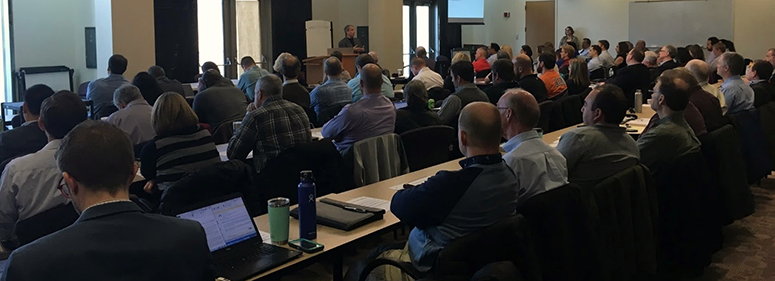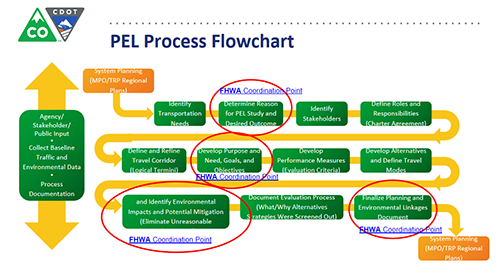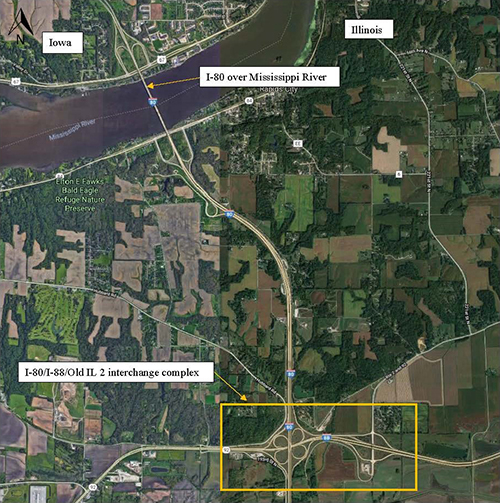Printer-friendly PDF →
Strategy: Planning and Environment Linkages Peer Exchange
Springfield, IL | December 10-11, 2018
This activity report summarizes the presentations and discussions. The summaries follow the order of appearance on the agenda. Each presentation summary is one page long, has a brief overview, findings, highlights from the participant discussion, and has a text box containing the speaker’s contact information. This peer exchange was funded through the Second Strategic Highway Research Program (SHRP2) product Expediting Project Delivery (C19).

Source: Volpe Center
Peer Exchange Notes
This peer exchange discussed Planning and Environment Linkages (PEL) approaches and focused on applying PEL to the I-80 bridge project on the Illinois-Iowa border. Seventy-eight stakeholders from Illinois
DOT, Iowa DOT, resource agencies, and
FHWA
headquarters and division offices attended the peer exchange. Colorado DOT served as the peer for this peer exchange and shared their experiences with PEL throughout the peer exchange to guide Illinois DOT in thinking about the I-80 PEL project.
Key Issues
Participants shared information on PEL approaches and worked to scope and identify needs for the I-80 PEL study.
Products
Participants defined a list of existing resources that can be used in the I-80 PEL study. Participants also identified required information that must be incorporated into the I-80 PEL study as it is undertaken.
Next Steps
Illinois DOT will move forward with the I-80 PEL study.
For More Information
Contacts
Marisel Lopez-Cruz
Planning and Environment Linkages Program Co-Lead
FHWA Office of Project Development & Environmental Review
(407) 867-6402 | Marisel.Lopez-Cruz@dot.gov
Resources
David Williams
Expediting Project Delivery Program Lead
FHWA Office of Project Development & Environmental Review
(202) 366-4074 | David.Williams@dot.gov
Presentations referenced in this document are available upon request to Madison.Burke@dot.gov.
What is PEL?
Contact
Marisel Lopez-Cruz
Jody McCullough
Organization
FHWA Office of Environment
FHWA Office of Planning
Presentation Summary Provided an overview of what PEL is, how PEL can accelerate project delivery, background information on PEL, the benefits of PEL, and regulatory information on PEL approaches
Phone
(407) 867-6402
(202) 366-5001
Email
Marisel.Lopez-Cruz@dot.gov
Jody.McCullough@dot.gov
Presentation Highlights
- PEL uses the information, analysis, or products developed during planning to inform the environmental review process.
- PEL is authorized under multiple statutory authorities, the most recent authorities being:
- 23
USC
168 outlines conditions for adopting or incorporating by reference a planning product.
- 23 USC 139(f)(4) describes requirements for eliminating alternatives if studied in planning.
- Many conditions for PEL are already completed as part of the normal transportation planning process.
- One Federal Decision sets a goal of reducing the average time for environmental review for major infrastructure projects to two years:
CDOT
PEL Study Framework & Resources
Contact
Sean Brewer
Organization
Colorado Department of Transportation
Presentation Summary CDOT leads a PEL program that focuses on larger-scale PEL studies. CDOT has completed 20 PEL studies since 2008. Through PEL, CDOT engages resource agencies and has found success with its Transportation Environmental Resource Council (TERC).
Phone
(303) 757-9978
Email
Sean.Brewer@state.co.us
Presentation Highlights
- CDOT’s PEL program focuses on fostering agency outreach, environmental scoping, and mitigation opportunities.
- The PEL process is flexible and can be used to make project or planning decisions.
- If a program or project is likely to have federal involvement in the future, PEL is a good tool to help streamline future National Environmental Policy Act (NEPA) processes.
- CDOT data from PEL studies can be used in NEPA if less than 5 years old.

Source: CDOT
Participant Discussion Highlights
Partner Engagement
Engaging resource agencies over years and establishing formal structures for engagement builds trust in the process.
Public Involvement
Public involvement is flexible in PEL. CDOT uses kickoff meetings and open project comments on their website and seeks to keep an open and transparent process through PEL.
Realizing Benefits
PEL is beneficial when construction money is not available. It is also beneficial to establishing a reasonable range of alternatives while eliminating unreasonable alternatives before NEPA.
Adopting PEL Approaches to
IDOT
Processes and Projects
Contact
Janel Veile
Organization
Illinois Department of Transportation
Presentation Summary Participants received an overview of the I-80 bridge project, which will be a PEL study. Participants then discussed the PEL study’s purpose and need, logical termini, and range of alternatives. Participants also identified existing resources that can be used in the PEL study and new information that will need to be identified during the PEL study.
Phone
(217) 558-7223
Email
Janel.Veile@illinois.gov
Discussion Highlights
- Illinois DOT will conduct a PEL study on the I-80 bridge linking Illinois and Iowa.

Source: Illinois DOT
Products Identified
- Through the discussion, participants identified the following resources to be used in the PEL study:
- A bridge inspection report for the I-80 bridge.
- Preliminary assessments of geometry.
- Crash data for the study area that can be used by the project consultant in a crash analysis.
- Travel demand model and analysis already conducted by Quad Cities MPO.
- Participants also identified the following pieces of information needed in the PEL study:
- Logical termini for the study area.
- A traffic analysis to assess safety issues along the corridor.
- Railroad interaction and bicycle/pedestrian issues will require study.
- Environmental Justice communities and tribes will need to be identified and consulted.

